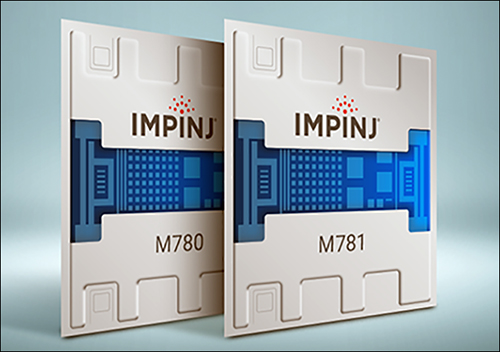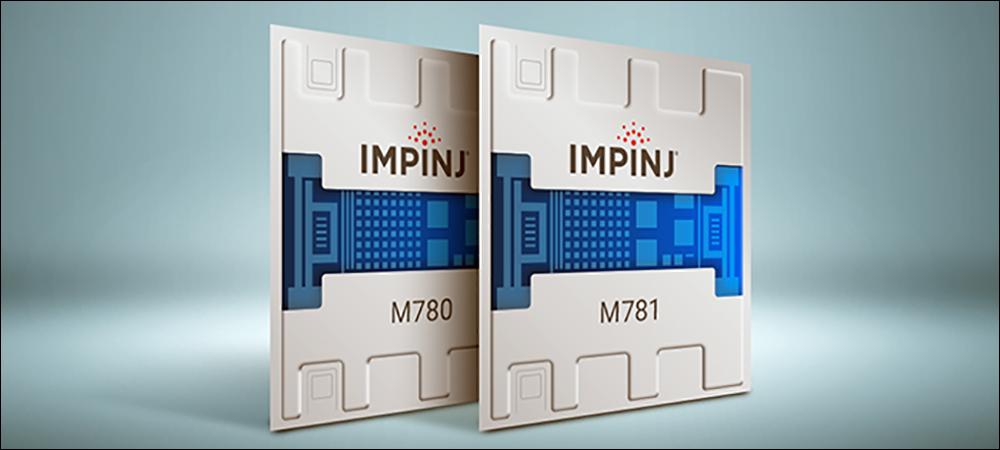- Addressing Compliance Demands for Food
- Improving Traceability for the Auto Industry
- RFID for Tracing Tires, Baggage and More
RFID technology company Impinj has released two new UHF [RAIN] radio frequency identification (RFID) chips aimed at industries that require tags with extended memory. (RAIN is a brand name for passive UHF RFID. The acronym “RAIN,” derived from RAdio frequency IdentificatioN, references the link between UHF RFID and the cloud, according to the RAIN Alliance.) The new chips are intended to meet a growing demand for RFID technology to manage goods in the manufacturing, food and pharmaceutical sectors, among other applications.

Impinj’s M780 and M781 chips
The RFID tag chips, models M780 and M781, offer the capacity for extended product identifiers and/or large user memory. Confidex has released eight new tags built with the M780 chips, and Arizon RFID Technology Solutions has designed 20 inlays so far. Both companies expect to design more with the M780 and M781 chips. The M780 comes with 496 bits of Electronic Product Code (EPC) memory and 128 bits of user memory, for those with long EPC ID number requirements. The M781 is aimed at users who need extra memory, as it comes with 128 bits for EPC and 512 user memory bits. Both chips support Impinj’s Core3D antenna reference designs for omnidirectional read range with a single antenna port.
The use of RFID tags has been widely adopted in the apparel, footwear and accessories retail market, while other industries have recently been migrating to the same technology to provide unique digital identification. Impinj’s says its long-term goal is to expand the technology’s use cases. “Our mission is to connect everything, trillions of everyday items,” says Martin Liebl, Impinj’s senior director for product management. With this in mind, he explains, the company built the new chips for use in traceability systems for the healthcare, pharmaceuticals, food, automotive and aviation industries.
These markets differ from retail, in which a simple EPC identifier encoded on a tag can be linked to a stock-keeping unit or other data managed on a server. Companies to which the newest chips are targeted require quick access to additional data, whether or not they have ready server access. For instance, product attributes such as batch or lot number, production date, expiration date, and the weight of a product or component could be written directly to a tag’s user memory. That information could be captured throughout a product’s lifespan to better manage shelf life, reduce waste, or ensure brands and retailers comply with regulations. A longer EPC number could provide access to longer descriptors in the ID.
Addressing Compliance Demands for Food
Many industries face regulatory requirements demanding automatic data collection that can be shared. The approach for meeting these regulatory demands is becoming more standardized as well, Impinj reports. “It is becoming more common for EPC and user memory specifications to be standardized within industries including pharma, food, aviation and automotive,” Liebl states. With clear standards, he says, supply chain and business partners can more easily share data electronically, as well as comply with encoding expectations, and they can quickly and accurately track and trace items of interest.

Martin Liebl
“While in retail applications,” Liebl says, “any data beyond the Electronic Product Code is stored outside of the tag chip, national regulations for applications like food demand data to be available on the tag chip.” To meet this demand, Impinj created the new chips (part of the company’s M700 series chips) as an improvement of the predecessor Monza 4 tag chips. When compared against the Monza 4, the company reports, the M780 and M781 offer improved receive sensitivity, which enables better read accuracy and a 50 percent increase in read range.
In addition to the greater memory capacity, Liebl says, these improvements allow partners to design smaller inlays without sacrificing performance. The new chips come with Impinj’s Protected Mode to secure tag data and enable privacy-sensitive applications. The new chips are the first to use the company’s Enhanced Enduro bonding pads, intended to provide mechanical stability, assembly consistency and reliability. Other additions include an Enhanced AutoTune adaptive RF tuning feature, an Enhanced Integra memory diagnostics suite and EPC pre-serialization.
The new chips support current GS1 tag-encoding recommendations, including the EPC Tag Data Standard (TDS) v2.0 (see Standards Group Provides RFID Guidelines for Food Services), which allows food industry supply chain partners to identify or locate products of a specific lot or batch for recall, or to monitor expiration dates to ensure older products are shipped or used first. User memory allows the storing of item-specific information to manage product shelf life and reduce waste. Details like expiration and production dates can manage the tracking of food and pharmaceuticals so supply chain partners can more easily pinpoint products of a specific lot or batch for recall.
Improving Traceability for the Auto Industry
Automotive companies need larger EPC memory to meet standardized encoding schemes. User memory can also enable data encoded directly to a tag, including after-market services such as recycling and product authentication. Confidex is focusing on the automotive industry with its new tags built on the M780 chips.

Miika Pylvänäinen
Tag makers have already begun building products that leverage the new chips’ functionality, according to Miika Pylvänäinen, Confidex’s director of RFID product line. Confidex’s Ferrowave Micro with the M780 IC, for instance, enables the encoding of data for automotive parts that meet the RFID tag-encoding requirements of VDA, a German automotive industry association that makes standardized recommendations. Confidex’s Crosswave Neo, he notes, offers similar 360-degree functionality as previous dual-dipole designs.
Of its eight new products, Pylvänäinen says, “These are a new generation of higher-memory products… that will enable Confidex’s customers to use standardized encoding schemes.” The company already offers high-memory tags, but with the M780 chip, Confidex’s latest tags will offer performance improvements including read range. For example, he says, “Vehicle identification outdoors or parts tracking, where we don’t have space for big RFID tags,” will be enabled by the smaller, high-performance, high-memory tags.
Additionally, Pylvänäinen states, “When the tag is more sensitive, it not only enables a longer read range but also gives our customer an option to reduce reader output power without sacrificing performance. This can be beneficial especially with portable readers, as it directly means longer battery life.” Confidex expects that customers currently using its predecessor tag, the M4, will migrate to the new tags, most of which are now available for order.
RFID for Tracing Tires, Baggage and More
Beyond automotive use, the International Air Transport Association (IATA) established Spec 2000 for tagging aircraft cabin equipment, which requires the 512 bits of user memory available in the M781 chip. Arizon RFID has announced a new product aimed at not only airline baggage, but also industrial, document control and tire tracking. In an Impinj blog, George Guo, the company’s VP of sales and operations, claimed, “The Impinj M780 and M781 chips make it possible to upgrade some of our longstanding tag designs with the latest performance and technology. And it allows us to design the tags with higher sensitivity to further meet customers’ requirements.”
All M700 series tag chips are antenna-compatible, Liebl says, enabling fast design cycles by tag and inlay companies. Impinj is also releasing its Core3D antenna reference designs to help tag and inlay manufacturers develop new antennas for applications requiring that tagged items be read at speed regardless of their orientation to a reader. This capability, he explains, is often needed for pharmaceuticals, aviation, manufacturing and document control, for which fixed readers are used in supply chain management. One common application involves reading a tag with 360-degree orientation as tagged items pass a reader on a conveyor belt.
The Core3D antenna reference designs emulate the 3D reading performance traditionally offered by dual-dipole antennas, Liebl says, but that 360-degree functionality could now be accomplished via a single-dipole antenna. That is important for companies focused on size, he explains. The single-dipole antenna design, together with the M700 series chips, takes up less space on a tag, while offering similar omnidirectional performance. “We expect that inlay and tag manufacturers will release smaller tag designs that deliver performance equal to, or better than, what was previously available,” he states.
Key Takeaways:
- Impinj has released two new UHF RFID chips that offer flexibility in user memory and EPC memory, enabling data of importance to those in the food, industrial or pharmaceutical markets to be stored directly on a tag.
- Tag manufacturers Confidex and Arizon RFID have released tags built with the M780 and M781 chips for automotive, baggage and other markets.


